| Reports of visits to Japan of POWs |
Former US WWII POWs visit Japan
at the invitation of the Japanese Government
2012-10-13/21
| the Commonwealth War Cemetery/Friendship Meeting |
| the Minister of Foreign Affairs | the Omori camp and Yokosuka | Niigata | Yamaguchi |
| Kobe | Osaka | Kyoto |
This is the third program that the Japanese government has run for former American POWs. Seven men and seven accompanying family members participated in this busy, yet fulfilling event. One, who was part of a B29 flight crew that bombed Tokyo, was captured after his plane was shot down and was later sent to the Tokyo Kempeitai. The others were captured in the Philippines or Guam and then later sent to POW camps in Japan or Manchuria.
During the one-week stay the group members spoke at various public forums held in honor of their visit. All were very eager to share their war stories and many in the audience asked questions wanting to know more, so many times these events went well beyond the scheduled finish time. At the halfway point of their stay, they split up and visited sites around Japan such as Tokyo, Yokosuka, Niigata, Osaka and Yamaguchi to see the former sites of camps that they had been interned at and/or to visit sites where they been forced to work during the war.
Despite the men being elderly, the youngest was eighty-nine, and often needing wheelchairs or walkers to get around all were able to successfully to come to and from Japan to complete the nine-day program. We are so grateful that they came for we have learned a lot by being in their presence and hearing their war stories and their thoughts about war.
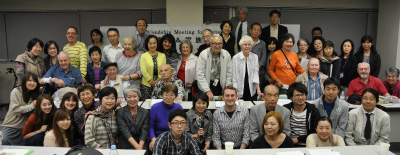
|
Description of the participants
|
Mr. Douglas Northam (92) In May, 1942 he was captured on Corregidor Island in the Philippines, spent time in camps at Bilibid and Cabanatuan, and then sent to Japan on the Nagato Maru. He spent time at the Umeda Branch Camp in Osaka and worked at Nittsu (Nippon Express) in Suita-city. Later he was moved to the Tsuruaga Branch Camp in Fukui prefecture and worked as a stevedore. |
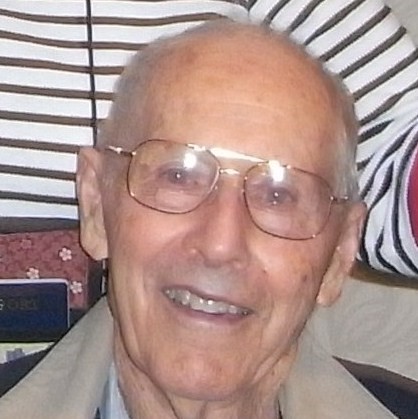
|
|
Mr. George R. Summers Jr. (90) He lives in Paradise, California. He joined the Idaho National Guard in 1939 and the U.S. Army Air Corps in 1940. He was captured on Mindanao in May 1942 and was shipped to Japan in October 1942 on Tottori Maru. He was held at POW camps in Kawasaki and Hitachi. After the war, he became a pharmacist and still works as relief at local pharmacies today. |
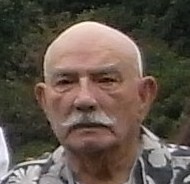
|
|
Mr. David Farquhar (90) He was captured in Guam in December, 1941 and sent to Japan on the Argentina Maru. He spent time in the Zentsuji camp in Kagawa prefecture, and the Tanagawa and Umeda camp in Osaka. He also worked as a stevedore for Fushiki Kairiku Unso at Takaoka city in Toyama prefecture. He visited Japan again during the Korean war. |
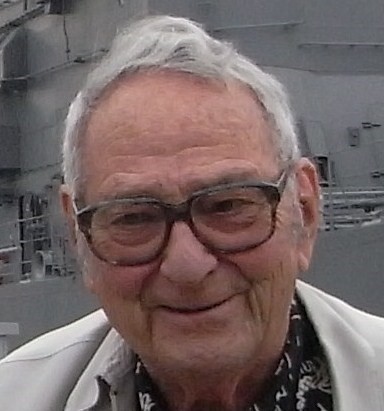
|
|
Mr. Randall Edwards (94) In May 1942 he was captured on Corregidor Island in the Philippines, sent to the Mukden POW camp in Manchuria and forced to work for MKK (Manchuria Machine Tool Factory). After the war he was stationed at Yokosuka as part of the Occupation Forces. |
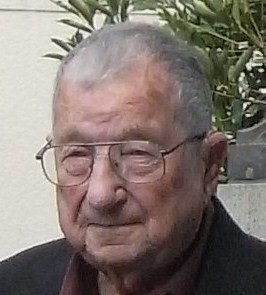
|
|
Mr. John Leroy Mims (90) He was captured on the Bataan Peninsula in the Philippines in April, 1942. He survived the Bataan Death March and after spending time in camps in the Philippines, he was sent to Japan where he was forced to work at the Omine coal mine in Mine city, Yamaguchi prefecture. After the war, he was stationed in Tokyo as part of the Occupation Forces. |

|
|
Mr. Robert Ehrhart (89) He was captured on Corregidor Island in the Philippines in May, 1942. Then after spending time in camps in the Philippines he was sent to the Hitachi Shipyard Sakurajima Branch camp in Osaka in 1943 where he worked as a riveter. Later, he went to the Mitsubishi Mining Company Akenobe Branch camp in Hyogo prefecture and the excavation of copper mines. |
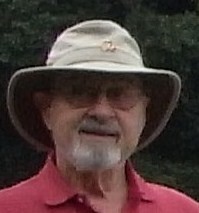
|
|
Mr. John Real (90) In April 1942, he was captured on the Bataan peninsula in the Philippines and survived the Bataan Death March. After spending time in camps in the Philippines he was sent to the Tokyo No. 5 Branch Camp in Niigata city where he worked as a stevedore doing such things as loading and unloading coal for the Niigata Kairiku Unso company. |
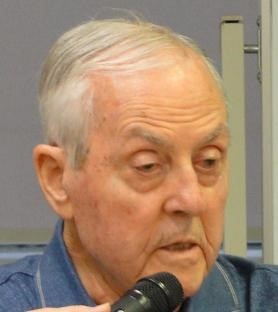
|
Schedule
| 13 Oct. (Sat) | Arrive at Narita airport |
| 14 Oct. (Sun) | Morning: visit the Commonwealth War Cemetery in Yokoyama Afternoon: Participate in a friendship meeting with local citizens in Tokyo |
| 15 Oct. (Mon) | Morning: Pay a courtesy visit with the Foreign Minister Gemba Afternoon: Participate in a public forum at Temple University |
| 16 Oct. (Tue) | Visit the American Embassy in Tokyo and attend a reception dinner |
| 17 Oct. (Wed) | Individual visits to Tokyo, Yokosuka, Niigata, Osaka, Yamaguchi |
| 18 Oct. (Thu) | Morning: Individual regional visits Afternoon: travel to Kyoto |
| 19 Oct. (Fri) | Morning: Visit Ryozen Kannon temple Afternoon: visit Kyoto Museum for World Peace at Ritsumeikan University and participate in a public forum |
| 20 Oct. (Sat) | sightseeing in Kyoto |
| 21 Oct. (Sun) | Depart from Kansai International airport. |
Oct. 14 (Sun): Morning visit to the Commonwealth War Cemetery in Yokoyama
 |
Most of the graves at this cemetery are of WWII soldiers from Commonwealth countries such as English, Australia, Canada, India and New Zealand who died in POW camps in Japan. However, in the charnel house. there are the names of forty-eight American soldiers, who left on the Oryoku Maru from Manila in December, 1944. But this ship was sunk by the American forces just outside of the Manila port, so the POWs were moved to the Enoura Maru, but this ship was also sunk at the Takao port in Taiwan. The POWs then changed to the Brazil Maru and arrived at the Moji port in Japan. Those who perished on Brazil Maru are listed in the Memorial. They laid flowers at the charnel house.
14 (Sun) afternoon: "Friendship Meeting" in Tokyo
>>For details, please look here
Place: Tokyo Azabudai Seminar House of Osaka University of Economics & Law
Organizer: Japanese Society for Friendship with ex-POWs and Families
Assisted by: POW Research Network Japan (POWRNJ) / US -Japan Dialogue on POWs
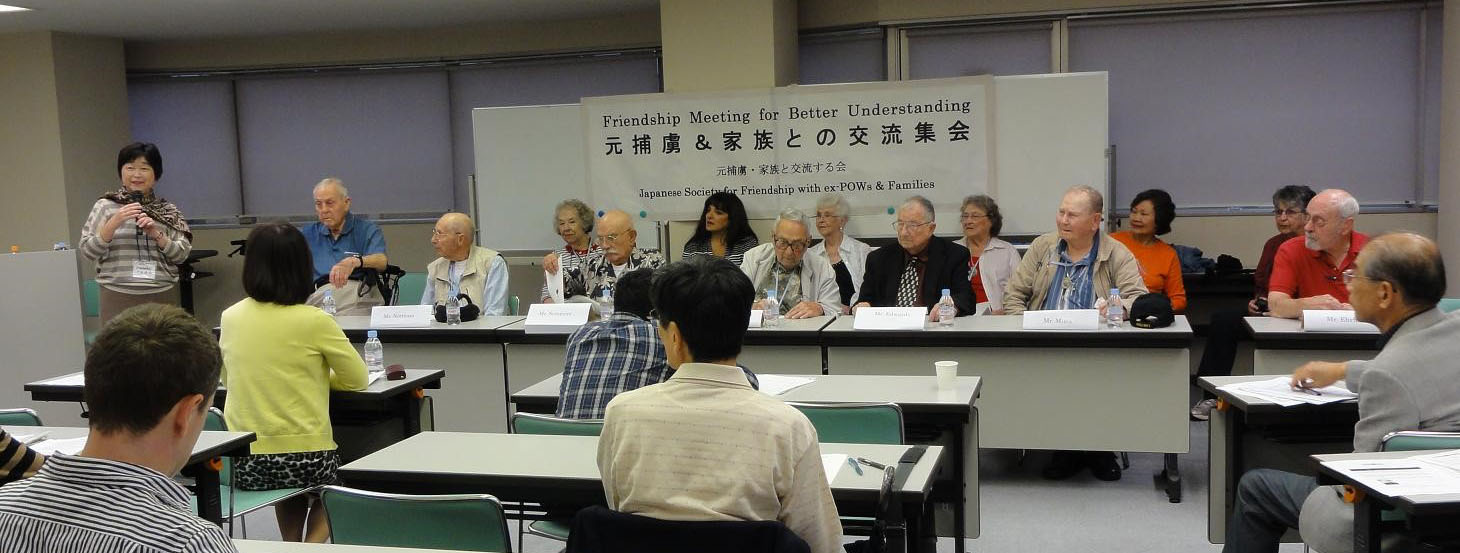
|
More than forty people attended this event during which each of the seven men told about their war experience. Here is a brief highlight from what their speeches.
Mr. Real, who survived the Bataan Death March, said, "Everything was taken away and we were forced to walk for sixty-five miles (100km) without food or water."
Mr. Northam, who is the leader of the visiting group, said, "We are near the end of our lives. I would like a word of apology from the companies that worked the prisoners so hard."
Mr. Summers, who became a prisoner in Guam one day after the war began, said, "When we were sent to Zentsuji the villages that I saw along the road were beautiful and tranquil."
Mr. Farquhar, who bombed Tokyo and spent time with the Kempeitai as a 'special prisoner', said, "I thought that I would be killed at the end of the war, but I was sent to Omori POW camp."
Mr. Edwards, who was sent to Mukden POW camp in Manchuria, said, "In order to prevent the Japanese war from proceeding, we sabotaged the factory machinery so that it would not work."
Mr. Mims, who is part Indian, said, "At O'Donell POW camp many prisoners died in succession, but my ancestors told me to keep my stomach area warm, so I was okay."
Mr. Ehrhart, who was sent to a POW camp in Osaka, said, "To keep my sanity, I drew cartoons using materials that I could get my hands on, but they were confiscated during a search."
Oct. 15 (Mon): A courtesy visit with Koichiro Gemba, the Minister of Foreign Affairs
Details on the Ministry of Foreign Affairs website (Japanese): >>Link
(Summary) Minister Gemba stated, "I hope that through this program will nurture in you a 'heart of reconciliation' towards Japan... Even more important is that I would like to express my heartfelt apology to those who had such a miserable experience as prisoners of war with great suffering and injury... It is my hope that this program continues in the future."
Douglas Northam, the representative leader of the group, said that this program is very worthwhile and we hope that it is continued. He presented a medal of friendship to the Minister.
 |
|
| (Photo was provided by MOFA) |
Oct. 17 (Wed): Visit to the site of the Omori camp and Yokosuka
Omori
Mr. David Farquhar and his wife along with Mr. Randall Edwards and his wife traveled to the site of the Omori camp where Mr. Farquhar had been liberated before going back to the United States and to Yokosuka where Edwards had spent time as part of the Occupation Forces. Tamura, Nishisato, Maekawa and Sasamoto from the POW Research Network accompanied them.
The site of the Omori camp is now the spectator stand of the Heiwajima Motorboat race, but beside it is a statue of Peace Kannon. Nearby a plaque states, "Heiwajima was the place of an internment camp of our opponent during the last large war. After the war it was was a place where our country's war criminals suffered, so to speak it is 'The land where war and peace are brought together.'..."
After the group visited the statue of the Peace Kannon, they went to a room for honored guests at Keikyu Kaihatsu Company, which owns the land, and welcomed by the staff.
Yokosuka
In the afternoon, the group went to the Yokosuka base of the Japan Maritime Self-Defense forces. A press officer started to explain the base by showing slides, but suddenly Mr. Edwards said, "This is the wrong place. I wanted to go to the US Naval base." So, plans were quickly rearranged and a staff from the Foreign Affairs took Mr. and Mrs. Edwards to the American base. Mr. and Mrs. Farquhar and four members of the POW Research Network stayed and were given a tour of the Maritime Self-Defense force base.
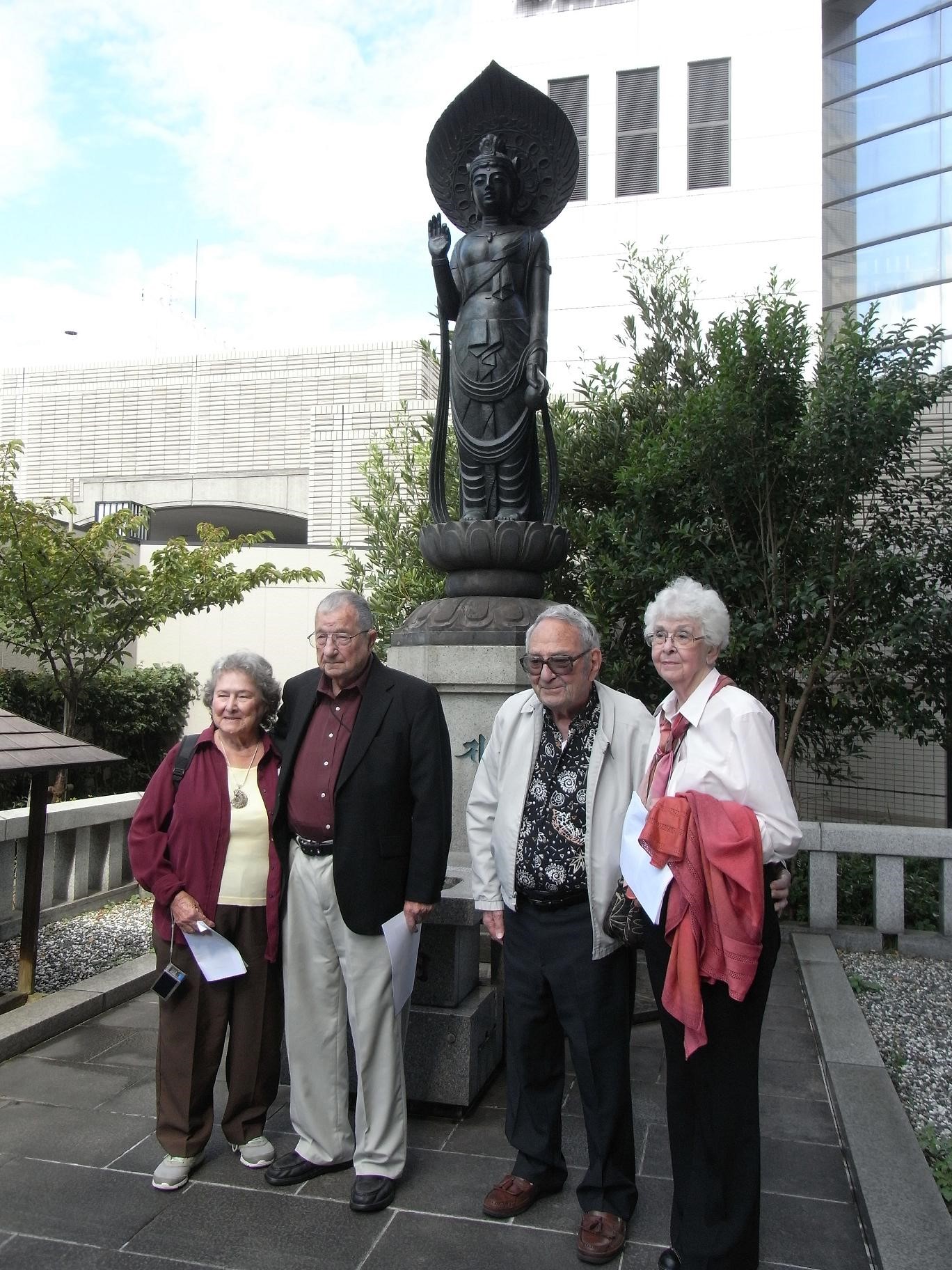 |
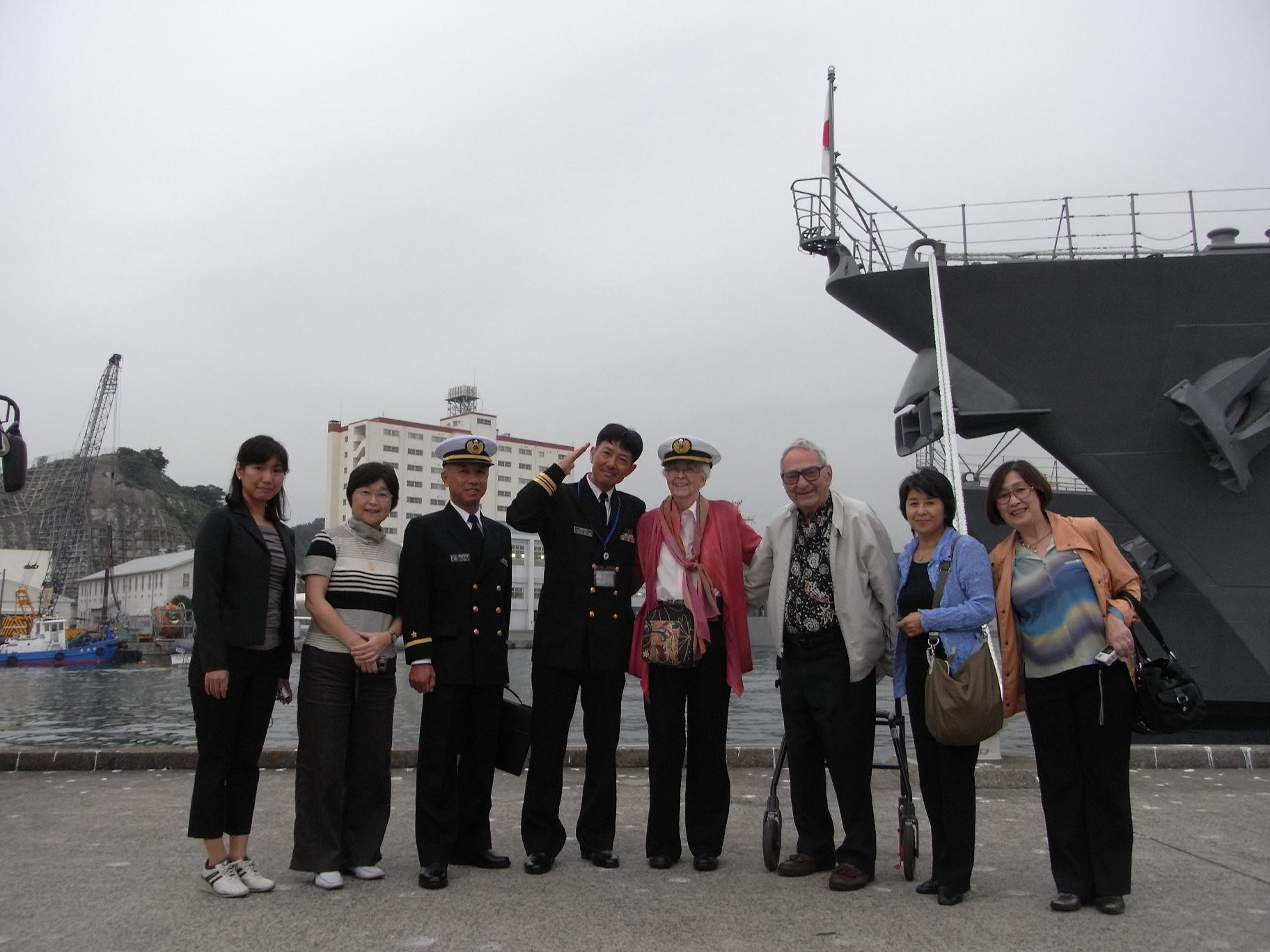 |
| In front of the Peace Kannon statue | At the Maritime Self-Defense Force base in Yokosuka |
Oct. 17 (Wed): Visit to Niigata
Initially Mr. John Real was included in the group to visit Tokyo and Yokosuka, but after arriving in Japan, he strongly expressed a wish to visit the site of the internment camp in Niigata, so in the evening of the 16th, his itinerary was quickly rearranged. That morning Akio Kimura, a member of the POW Research Network who lives in Niigata, was told of the sudden change and very kindly excused himself from an important meeting to act as a guide for John and his son.
The former site of Niigata Kairiku Unso (Tokyo No. 5 Branch camp) has totally disappeared with houses and apartment buildings, but Mr. Real told a story of when he and the POWs went to work at the port, the local people would throw rocks at them. After this, they went to see the pier at the Niigata port. According to Mr. Real the POWs were forced to load and unload coal. At the top of the Water Bureau tower, the group could view the Shinano River, Sea of Japan and surrounding town. Despite the landscape having completely changed from during the war, Mr. Real was very satisfied to be able to visit Niigata.
Oct. 17 (Wed) –18 (Thurs): Visit to Yamaguchi
Mr. John Mims and his wife went to Yamaguchi prefecture. In Ube city they went to the head office of Ube Industries that ran the Omine coal mines and then to Mine city to the site of the Omine camp (Hiroshima No. 6 Branch camp). They were accompanied by Ms. Yukako Ibuki from the US -Japan Dialogue on POWs group.
During the visit at Ube Industries, they were shown a film on the working conditions at the copper mine forty years ago. Then in the exhibition room they watched an introductory video in English about the company and then viewed the exhibits related to copper mining.
On the 18th, after visiting with the Mayor of Mine, Mr. Koji Murata, they visited the entrance to Omine copper mines and site of the former camp under the guidance of Mr. Masami Hasama and Mr. Fumio Yamamoto who are members of a group called, "Itsuka no Kai" that records the war experiences of the local people. Along the way, children of a kindergarten that Mr. Hasama runs waved American and Japanese flags welcoming Mr and Mrs. Mims. At the site of the former camp there is a memorial stone that the "Itsuka no Kai" group erected. Mr. Mims laid flowers at the stone and related stories of when he was beat up injuring his neck and paralyzing his body.
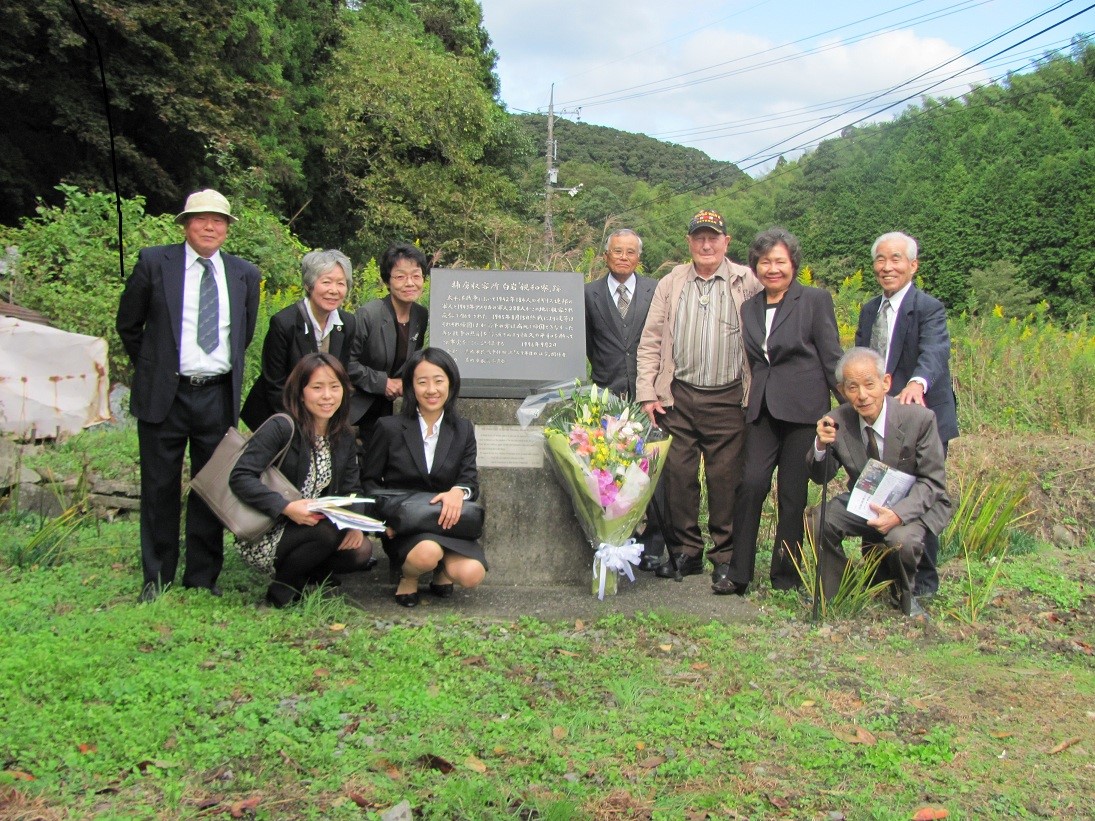 |
|
| The memorial stone at Omine POW camp (provided by Tetsuro Tanaka) |
October 17 (Wed): Visit to Kobe
During the war, Mr. Douglas Northam, Mr. George Summers and Mr. Robert Ehrhart spent time in camps in Osaka, so today they went to Kobe by shinkansen (bullet train) from Tokyo. Accompanying them were staff from Dentsu, staff from the Foreign Ministry, Fukubayashi from the POW Research Network, and Ms. Kinue Tokudome from the US -Japan Dialogue on POWs group.
Initially the group was to have lunch while on a cruise of Kobe port, but the weather was not favorable and it was too inconvenient for some to get on a boat, so the plan was changed. Instead they had lunch on the Observation level of the Oriental Hotel overlooking Kobe port.
Around 4pm, the group went via chartered bus to Hitachi Shipyard Chikko factory in Osaka. Last year Mr. Jack Simmons, a former prisoner of war from Australia, visited here and like him they saw what was left of the factory, heard explanations about its history from the staff who had prepared photographs and other materials. It was a great learning experience for all. Mr. Ehrhart spent time at the Hitachi Shipyard Sakurajima factory so he did not have direct relation with this factory, but the staff members were very welcoming and polite.
October 18 (Thurs): Visit to Osaka
The site of the Nittsu Transport Umeda Branch camp
In the afternoon of the 18th, Mr. Douglas Northam, Mr. George Summers and Mr. Robert Ehrhart along with staff from Dentsu, nurses, staff from the Foreign Ministry, Ms. Kinue Tokudome from the US/Japan POW dialogue group, David Moreton and the Toru Kobayashi from the POW Research Network visited the Nittsu Transport Umeda branch. Across from the presently used Nittsu building they could see the enormous Umeda freight station and with its numerous tracks and storage areas. This is where Mr. Northam and Mr. Summers spent time as prisoners.
The manager of the Nittsu Head Office welcomed everyone and showed them a book about the history of the company, which had an article about student laborers during the war, but did not include any references to the prison camp. While looking at Umeda freight station Mr. Northam and Mr. Summers could conjure up memories of what it was like seventy years ago, but actually both of them did not spent here but at the freight stations close to the train station in Suita city and Osaka port. Just before the group left, the manager expressed his appreciation to the group for visiting. Mr. Summers replied, "If only we had received treatment like this during the war, things would be been much better."
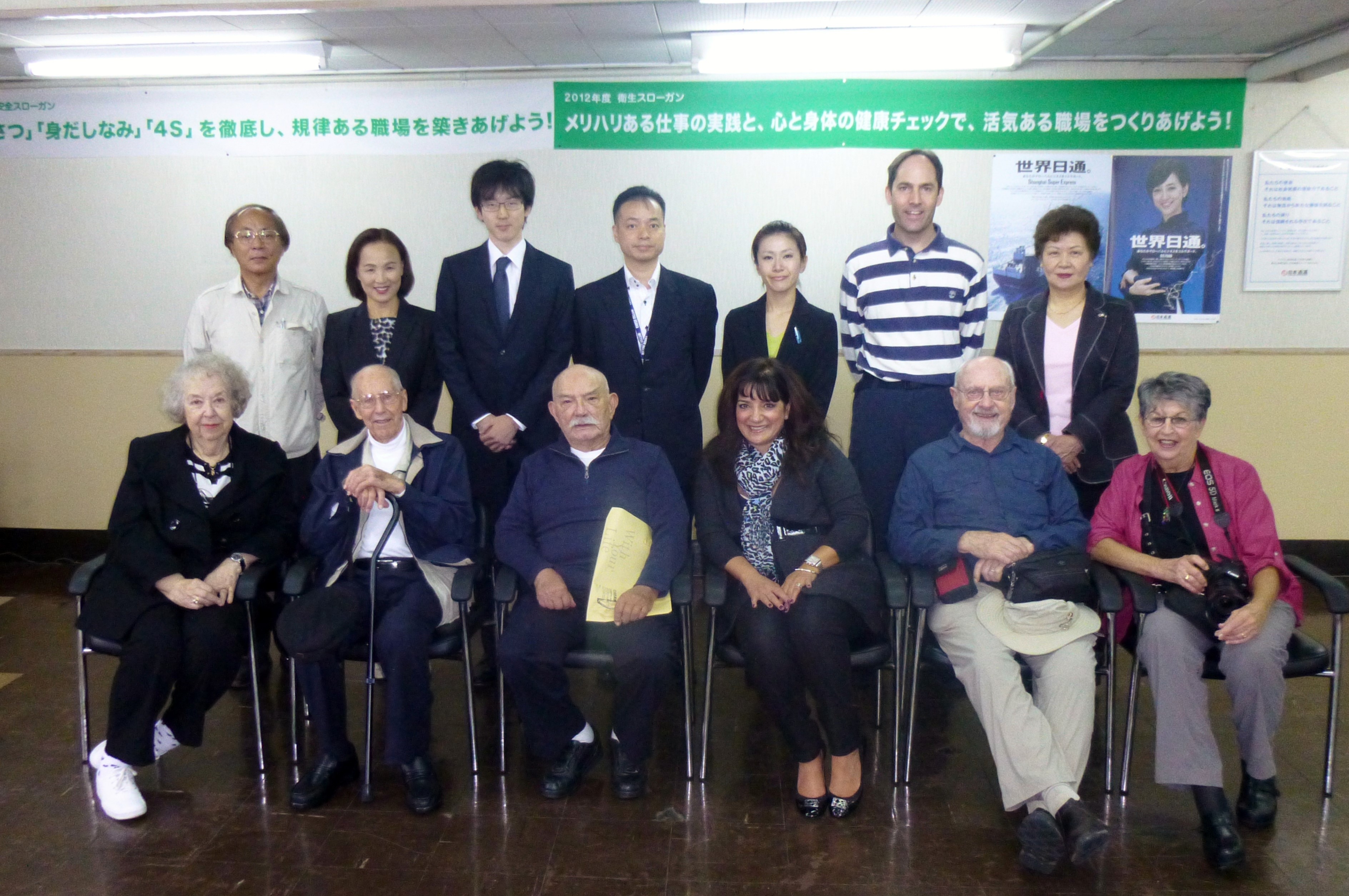 |
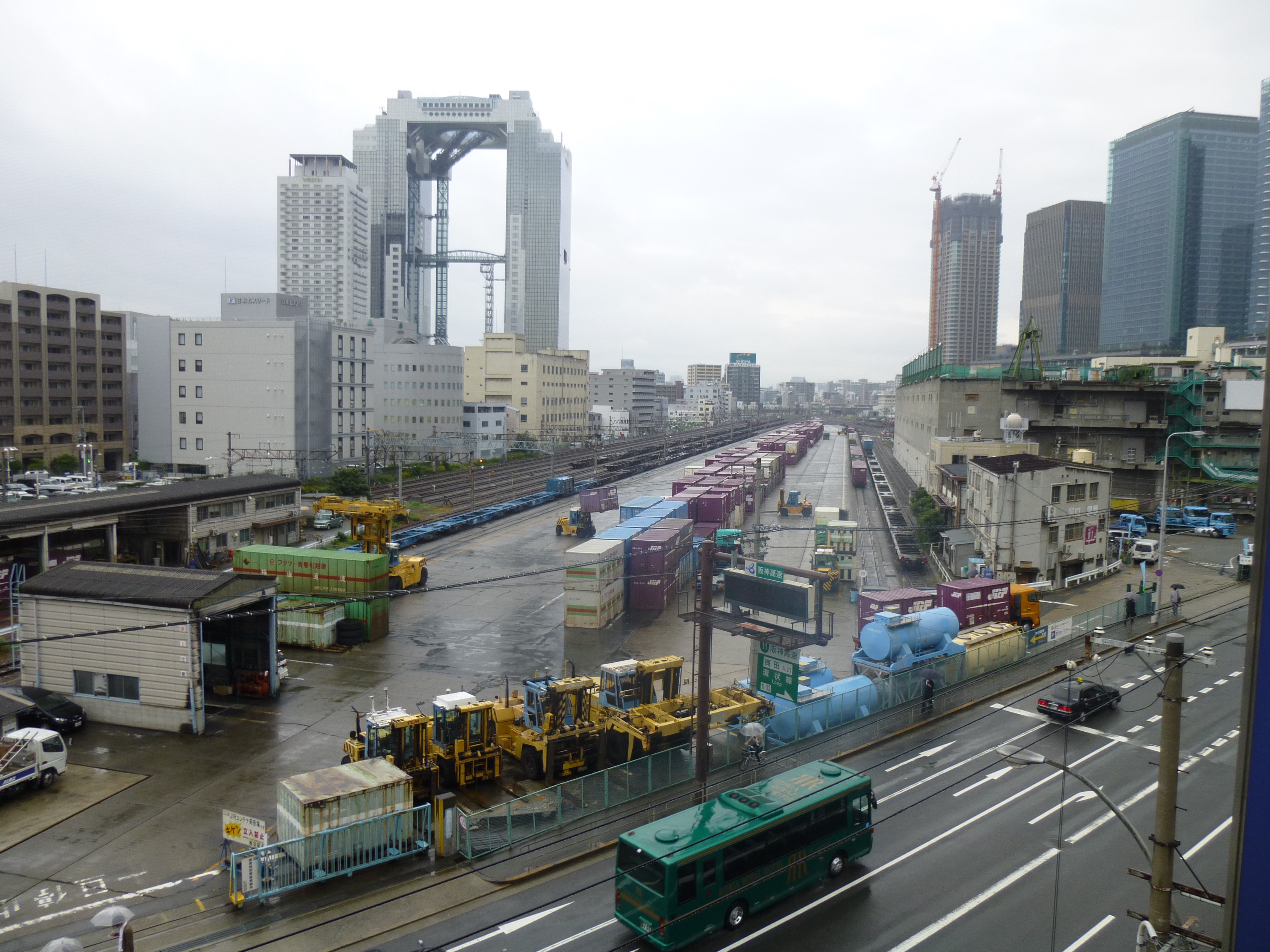 |
| At the Nittsu Umeda branch | Umeda freight station |
Visit to Takami elementary school in Osaka
Next, the group visited Takami municipal elementary school in Osaka. This school is close to where Mr. Ehrhart spent time at the Hitachi Shipbuilding Sakurajima Branch camp. A few years ago when a book on the school's history was being produced, the teacher in charge of editing saw the website of the POW Research Network and contacted Toru Fukubayashi, who provided some information about the camp. Thanks to this connection when it was decided that a group of former American POWs would be visiting Japan, this news was told to the principal and local people and who arranged this welcome event at the school. Upon arrival, the group was escorted to a classroom where approximately ninety Grade 5 students, staff, and twenty local people were waiting to listen and to ask questions. Some students asked: "Why did you join the Army?", "What do you think about the atomic bomb?", "Why did the war start?" At the end of the question and answer period, a representative of the Grade 5 classes presented a photograph of the Grade 5 students along with messages from each student. Then first year students came and welcomed the group with a performance of musical instruments and singing. At lunchtime, about twenty students enjoyed eating with the group.
Reporters from the Yomiuri Shimbun (Japanese newspaper) and Stars and Stripes (American military newspaper) came and later published articles about the event in their newspapers.
 |
 |
| At Takami elementary school | The former site of Hitachi Shipbuilding Sakurajima Branch camp |
Visit to the Peace Osaka Museum
After the elementary school, the group went to Peace Osaka Museum where they were shown the exhibits describing the bombings of Osaka and of the history of the Pacific War. An informal discussion was then held with about twenty-five museum staff and local people. Among those that attended was Mr. Koichi Ikeda (91), who was a prisoner of war in Siberia, and knows Mr. Tenney, who was a POW during WWII and participated in the first program to Japan; Mr. Shigeo Yamashita (86) who saw the prisoners going to the factory every day and after receiving the Petty Officer pilot Preliminary training course was a crew member for midget submarines; and Ms. Takako Iga (81), a survivor of the bombings of Osaka, who realized that it was war when she witnessed prisoners being forced to work at the Imamiya railway station in Osaka city as she went to and from school.
Reporters from the Stars and Stripes newspaper came.
Then the group proceeded by bus to Kyoto. At first, there was a plan to see the area around the Asahi brewery close to Suita railway station where Mr. Northam had worked, but he said, "Today has been a very fulfilling day, so there is no need to go there." So, the group went directly to the hotel in Kyoto.
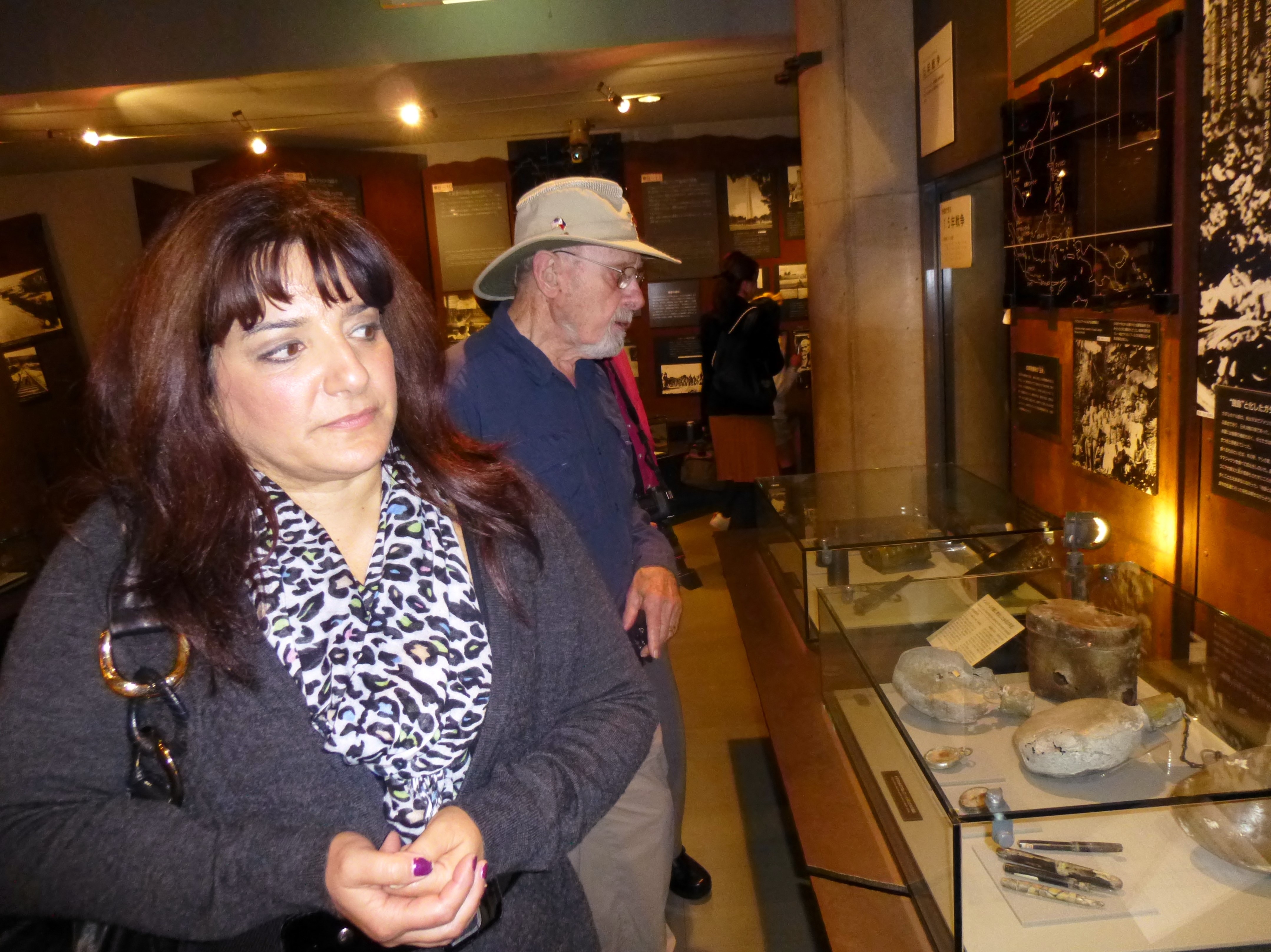 |
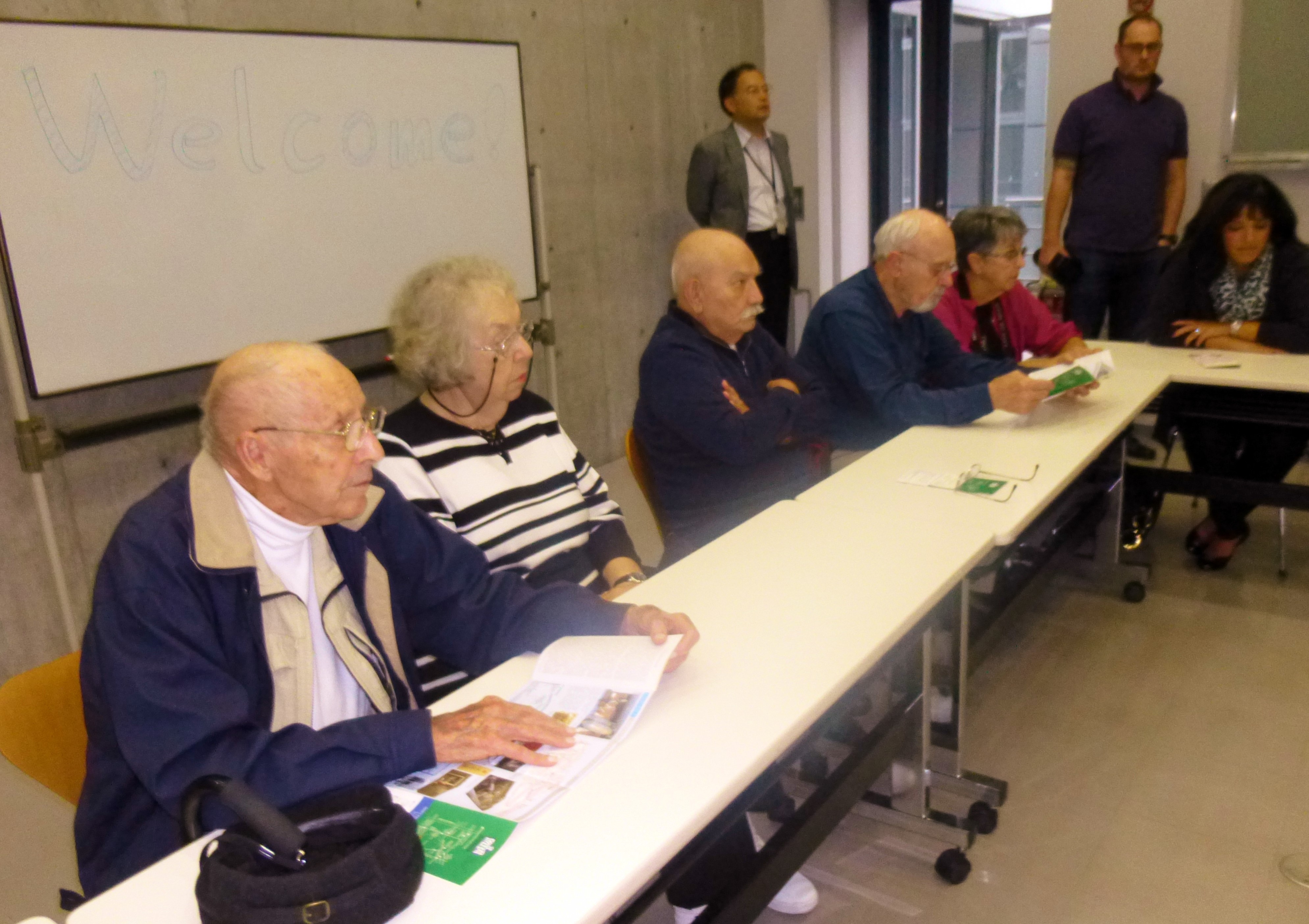 |
| Peace Osaka tour | Meeting at Peace Osaka |
October 19 (Fri): Kyoto
Visit to Ryozen Kannon Temple
After the group had split up and visited different places throughout Japan, they reassembled in the evening of the 18th at the Granvia Hotel in Kyoto. Then in the morning of the 19th, staff members from Dentsu, nurses, Ms. Yukako Ibuki from the US -Japan Dialogue on POWs group, David Moreton and Toru Fukubayashi from the POW Research Network, went with the group to visit Ryozen Kannon.
At the temple the group was able to view the "Mortuary Rolls" and prisoner of war cards that are stored in the Memorial Hall. A visit here has been part of the program since the "Friendship Programs" with former American and Australians POWs started three years ago. David Moreton explained about the records and the history of the temple to the group after which many looked for people they knew.
Then the group had lunch at a nearby Japanese restaurant and afterwards went to the Peace Museum at Ritsumeikan University to see the materials on display and to participate in a public forum.
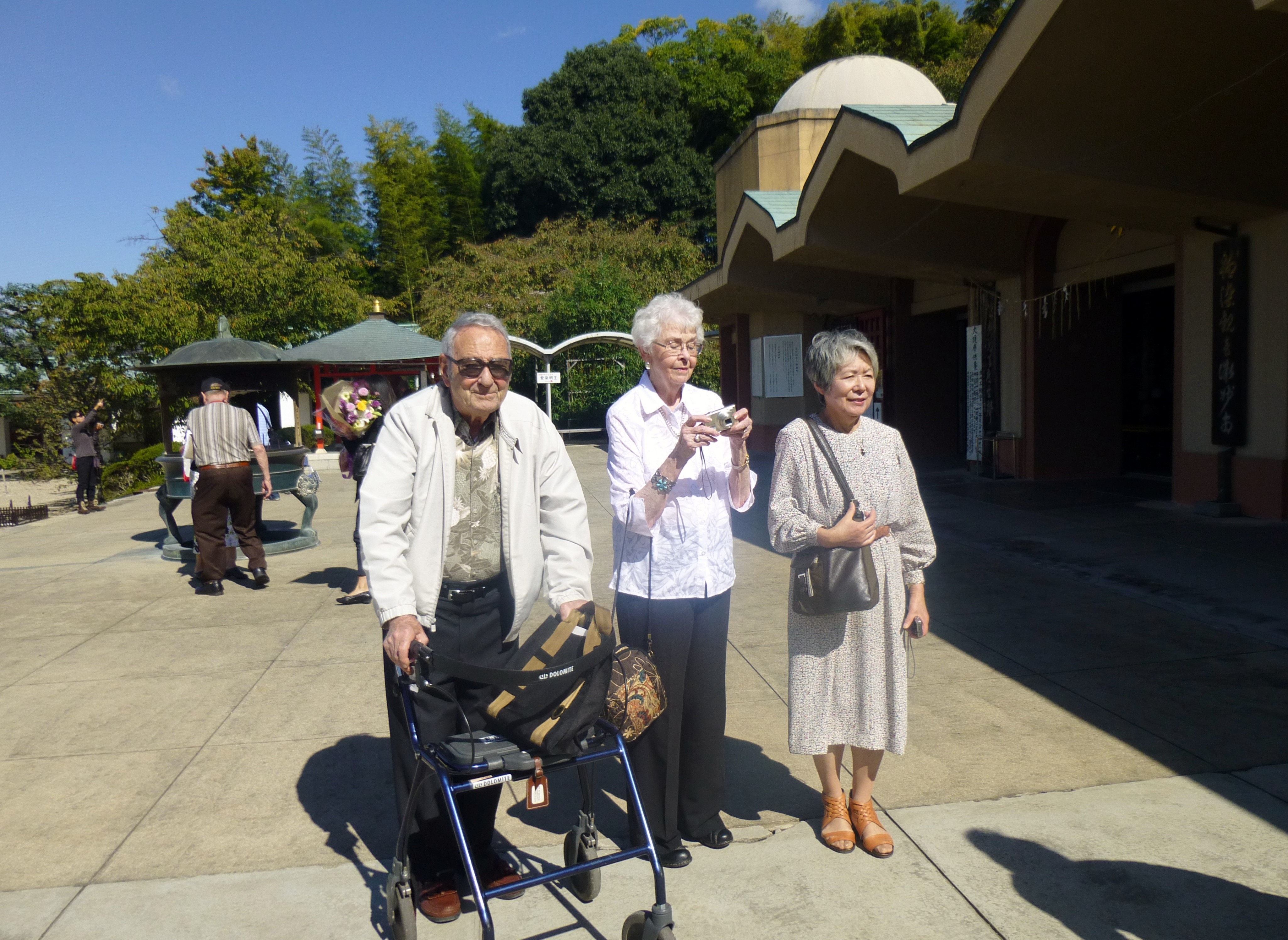 |
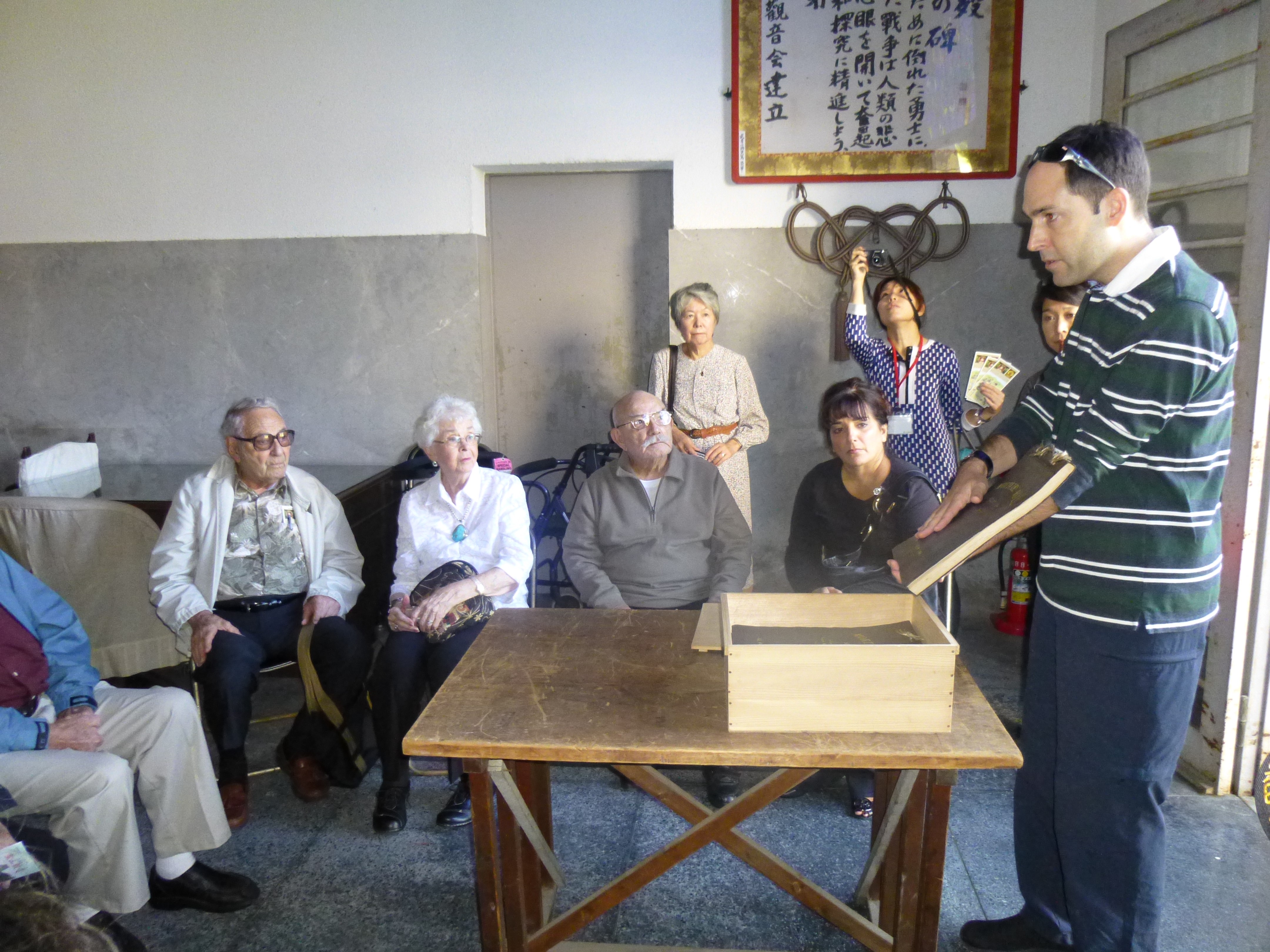 |
| On the temple grounds of Ryozen Kannon | Looking at the "Mortuary Rolls" in the Memorial Hall |
Visit to Kyoto Museum for World Peace at Ritsumeikan University
Here the group was greeted by many volunteers and museum staff and then escorted to the exhibition room for a tour of the museum. From 3pm, a public forum was held with about seventy people in attendance. This year thanks to the assistance from such groups as "Senso iseki ni heiwa wo manabu Kyoto no kai" and "Heiwa tomo no kai"and others, news about this forum was spread to students and faculty of Ritsumeikan University. As well, an article in the Kyoto Shinbum before had helped to attract people to attend.
Here are some of the questions and answers heard at the forum:
Q: Did you not feel guilty for causing destruction among the common people during the bombings of the cities?
A: I feel bad that common people were caught up indiscriminately through these bombings, but we were told that factories in the cities were making parts for military use and thus we were ordered to bomb. To some extent, it could not be helped.
Q: How do you feel about the dropping of the atomic bomb?
A: The purpose of the atomic bomb was to put an end to the war at once, and thus it could not be prevented. It is well known that we as POWs were saved due to the dropping of the atomic bomb and that by ending the war sooner many lives were saved.
Q: Does America intend to protect Okinawa or does it intend to occupy it? I cannot but think that it is a form of occupation.
A: I do not think it is an occupation. American forces are deployed in Okinawa to protect Okinawa and Japan. It is a fact that having American forces here helps Okinawa economically.
Q: What do you think about the rape incident by an American soldier in Okinawa?
A: That soldier did something based on his own selfish desires. He should be tried and, if found guilty, be given an appropriate sentence.
Q: Can war be justified?
A: There is no one who can justify war. No one is happy when there is war. I know this because I was in Niigata, one of the proposed sites for the bombing of the atomic bomb.
As well, one of the former POWs said, "About 23,000 American soldiers became prisoners of war. At present there are only about 100 still alive. Of those six are here with you today."
One of the Japanese participants said, "It is a rare opportunity to hear directly from former prisoners of war. I am honored that I could attend such an important forum like this."
A reporter from the Kyoto Shimbum came and the next day, published an article about the event.
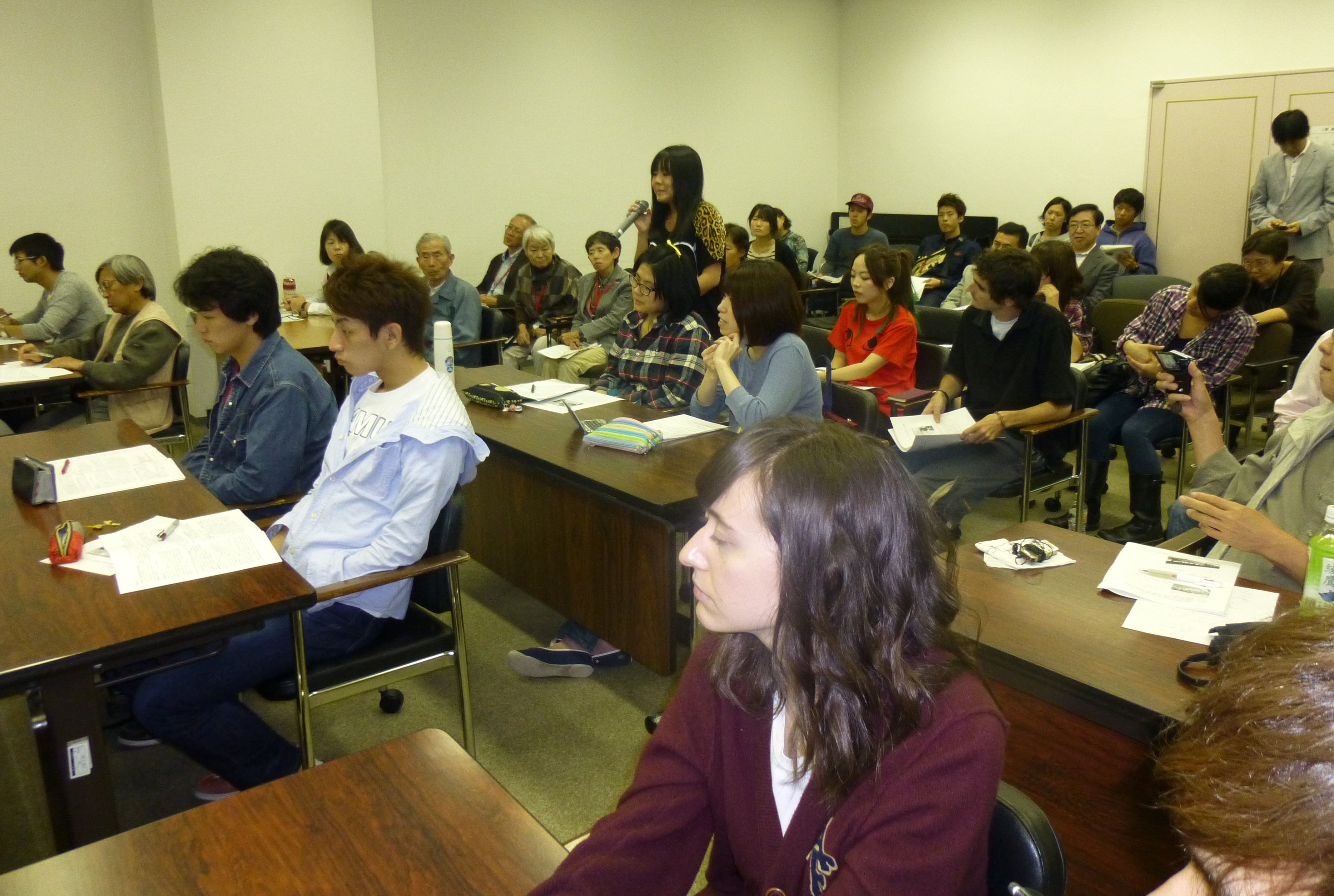 |
 |
| Public forum with local citizens and students |